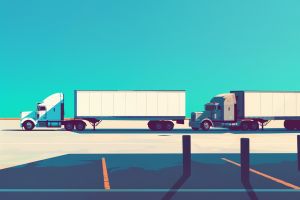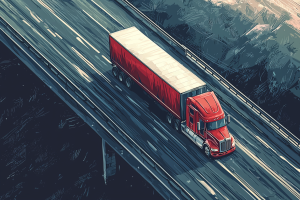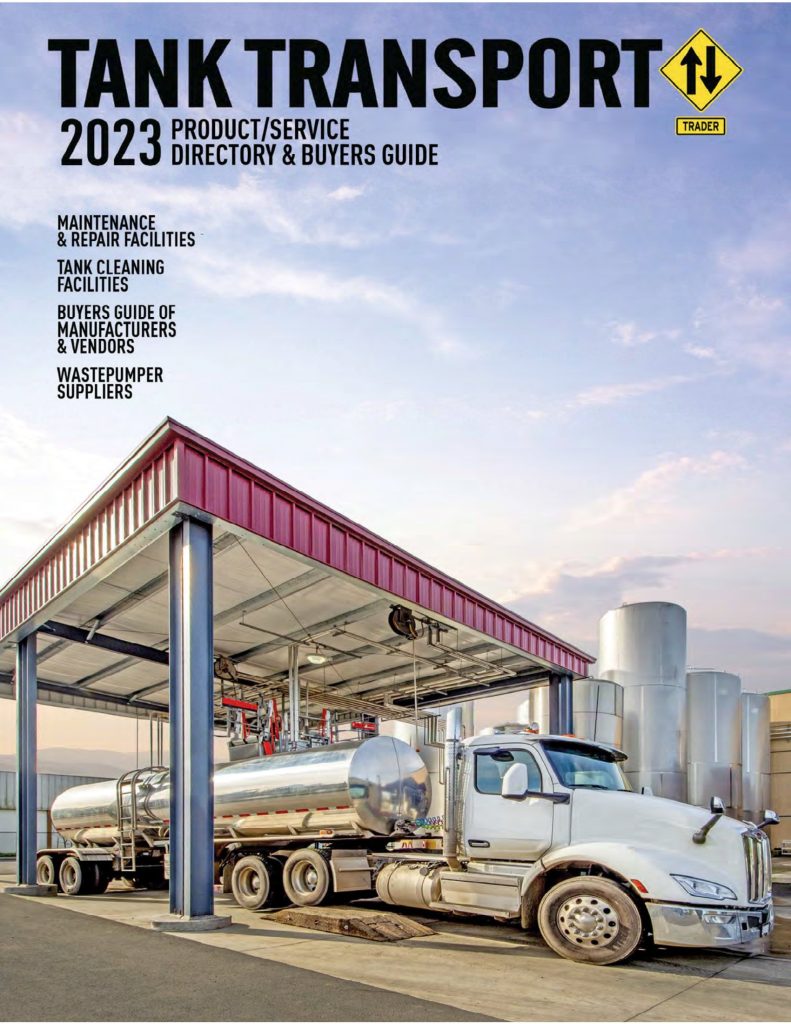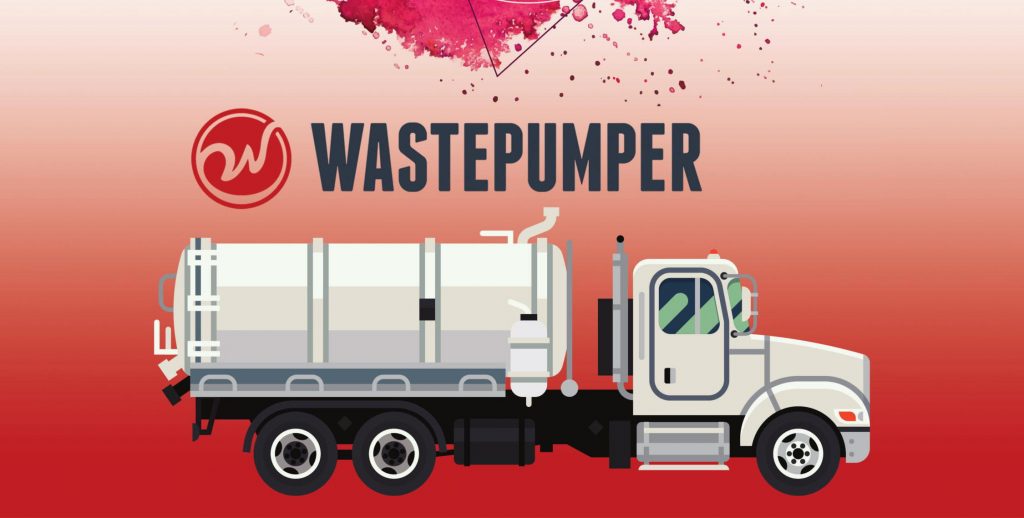- Infrastructure Bills Trucking: Discover how the latest $3.4 billion investment is revolutionizing road safety and efficiency for the trucking industry.
- Unveiling New Horizons: Dive into the largest federal funding initiative since the Interstate Highway System—what does this mean for tomorrow’s trucking routes?
- Safety Reimagined: Learn how new mandatory safety standards like automatic braking are setting new benchmarks for trucking operations across America.
Infrastructure Bills Trucking: A Comprehensive Overview

Recent infrastructure bills are revolutionizing trucking, ensuring safer and more efficient transport across the nation.
Recent infrastructure bills are significantly impacting the trucking industry, with substantial investments improving highways, bridges, and rest areas across the nation. The trucking industry is vital to the U.S. economy, responsible for transporting 72.5% of the nation’s freight by weight. With the federal government injecting unprecedented funding into infrastructure modernization, these initiatives address longstanding issues in road maintenance, bridge safety, and rest area facilities, directly enhancing trucking operations.
Government Investments and Infrastructure Bills in Trucking
Bipartisan Infrastructure Law (BIL) and Its Impact
“As of November 2024, the U.S. Transportation Secretary Pete Buttigieg announced over $3.4 billion in grants to support various infrastructure projects, including road safety enhancements and supply chain improvements.” – U.S. Department of Transportation
This funding is part of the Bipartisan Infrastructure Law (BIL), which earmarks significant resources for the trucking sector, such as road and bridge repairs crucial for reducing vehicle wear and tear and enhancing operational efficiency.
-Read more about recent Federal Motor Carrier Safety Regulations changes.
Enjoying our insights?
Subscribe to our newsletter to keep up with the latest industry trends and developments.
Stay InformedInfrastructure Investment and Jobs Act (IIJA)
“The Infrastructure Investment and Jobs Act (IIJA) is allocating $477 billion in new funding over five years for surface transportation programs, including $351 billion specifically for highways.” – American Trucking Associations

Over $3.4 billion in grants aim to enhance road safety and supply chain efficiencies.
For the trucking industry, this represents the largest federal funding injection into the nation’s bridge network since the formation of the Interstate Highway System, providing measurable cost and time savings for trucking operations.
-Discover how infrastructure funding is shaping the future of transportation.
Insights from the Third Anniversary of the Bipartisan Infrastructure Law
The third anniversary of the Bipartisan Infrastructure Law marks significant progress across various sectors, particularly in transportation. Highlighting $3.4 billion in grants directed towards enhancing road safety and supply chain efficiencies, this update underscores the law’s profound impact on the trucking industry.

The infrastructure investments aim to modernize the nation’s roads and bridges, potentially easing the operational challenges faced by the trucking industry.
These funds have been instrumental in advancing projects that reduce vehicle wear and tear while bolstering operational efficiency—critical factors for the trucking sector’s growth and reliability. The continued governmental focus on infrastructure development not only supports current logistical needs but also lays a strong foundation for future technological integration in the trucking industry.
Highway Improvements: Benefits to the Trucking Industry
Enhancing Road Conditions for Efficiency
Aging highways have long been a concern for truck drivers and trucking companies. Poor road conditions lead to increased vehicle maintenance costs and pose safety risks. With the new infrastructure bills trucking stakeholders have supported, significant resources are allocated to highway improvements.
-Explore our coverage on Highway Funding.

Upgraded highways mean smoother rides, reduced vehicle wear, and lower maintenance costs.
Upgraded highways will result in smoother rides, reducing wear and tear on trucks. This lowers maintenance costs and improves fuel efficiency. Moreover, better road conditions enhance truck driver safety, reducing the likelihood of accidents caused by potholes or uneven surfaces.
Alleviating Congestion Through Expansion
Highway improvements under the infrastructure bills include widening lanes, adding new routes, and implementing smart highway technologies. These enhancements will alleviate congestion in major corridors, a significant issue that leads to delays and increased fuel consumption for trucking companies. The implementation of advanced pavement materials will extend the lifespan of highways, reducing the frequency of repairs and associated disruptions.
Bridge Upgrades: Enhancing Trucking Safety and Efficiency
Addressing Structurally Deficient Bridges

The largest federal funding in decades is set to transform the nation’s bridge network, promising substantial time and cost savings.
Bridges are crucial nodes in the transportation network, yet over 45,000 bridges in the United States are classified as structurally deficient. Many are outdated and not equipped to handle modern trucking demands. The infrastructure bills trucking advocates have supported include substantial funds for bridge upgrades.
-Learn more about the economic impact of infrastructure investments on trucking.
Modernizing for Increased Load Capacity
Modern bridges are designed to accommodate heavier loads and increased traffic volumes, essential as the demand for freight transportation grows. Enhanced bridges also incorporate seismic retrofitting in earthquake-prone areas, ensuring that critical transportation routes remain operational even after natural disasters.
-For further insights into advancements in Trucking Technology, follow this link.
Revamping Rest Areas: Positive Effects on Trucking
Improving Driver Well-being and Compliance

Enhanced rest areas significantly improve driver well-being and compliance, contributing to safer and more efficient road conditions for the trucking industry.
Rest areas provide essential services for truck drivers, offering places to rest, refuel, and attend to personal needs. The condition of rest areas directly impacts driver well-being and compliance with hours-of-service regulations. The infrastructure bills allocate funds to revamp rest areas, improving facilities and increasing the number of available parking spots for trucks, enhancing the overall driver experience.
-Stay updated on Transportation trends and policies.
Enhancing Amenities for Driver Satisfaction
Enhanced rest areas contribute to truck driver safety improvements by reducing fatigue-related incidents. With better facilities, drivers can rest adequately, leading to increased alertness on the road. Modern rest areas equipped with amenities like Wi-Fi and healthy food options can improve the quality of life for drivers, potentially aiding in driver retention for trucking companies. These improvements go beyond basic renovations; they include the development of facilities that support electric vehicle charging, including for electric trucks, which are expected to become more prevalent. The inclusion of security measures, such as improved lighting and surveillance systems, enhances driver safety during rest periods.
Transportation Infrastructure Funding and Trucking
Understanding Funding Allocation
Understanding the details of transportation infrastructure funding is crucial for industry insiders. The funds are distributed across various projects, including road maintenance, bridge construction, and rest area renovations. Trucking companies can anticipate changes in routes due to construction and plan accordingly. Moreover, knowing where investments are made can help companies strategize their operations to take advantage of improved infrastructure.
Opportunities for Industry Engagement

Advanced technologies in infrastructure are paving the way for a more connected and efficient transportation network.
Transportation infrastructure funding is distributed through various federal and state programs. The infrastructure bills include provisions for competitive grants, allowing states and municipalities to propose projects that address specific local needs. Engaging with local government agencies provides opportunities for trucking companies to influence project priorities that directly affect their operations.
-Read the latest updates on government grants and their effects.
Truck Safety Enhancements Under New Legislation
Mandatory Safety Rulemaking
The focus on improving truck safety through mandatory rulemaking for new trucks reflects a commitment to enhancing operational safety within the industry. This includes the implementation of automatic emergency braking systems and the study of side underride guards. Such measures aim to reduce accidents and improve overall road safety, proactively safeguarding both drivers and the public.
-For further insights into advancements in Truck Safety, follow this link.
Investing in Advanced Safety Technologies
By investing in advanced safety technologies, the infrastructure bills trucking companies support are not only improving safety for drivers but also reducing liability and insurance costs. Enhanced safety features lead to fewer accidents, which can result in lower premiums and protect companies’ reputations.
Economic Impact on Trucking and Supply Chain Efficiency
Reducing Operational Costs

Modernization of infrastructure prepares the trucking industry for future challenges and opportunities.
The investments in infrastructure modernization directly impact the economic aspects of trucking by reducing operational costs. Improved highways and bridges lead to better fuel efficiency and less vehicle wear and tear. This translates to lower maintenance costs and higher profitability for trucking companies, bolstering the financial health of the sector.
-Explore how these changes are influencing Operational Costs in more detail.
Enhancing Supply Chain Reliability
Infrastructure improvements also enhance supply chain efficiency by reducing delays caused by poor road conditions or congestion. Reliable transportation networks ensure timely deliveries, which is crucial for industries that rely on just-in-time inventory systems. This reliability strengthens the trucking industry’s role in the national economy, supporting a more robust supply chain infrastructure.
-Learn more about the improvements in Supply Chain efficiency, here.
Future of Infrastructure Legislation in Trucking
Continued Investments and Modernization

Every dollar invested in infrastructure returns dividends in operational efficiency and supply chain reliability.
The future outlook for infrastructure legislation in trucking is promising. Continued support and investment are expected to further modernize infrastructure, benefiting the trucking industry. Looking ahead, infrastructure legislation is expected to evolve to address emerging challenges like climate change and technological advancements, preparing the sector for future needs.
Preparing for Technological Integration
Technological advancements, such as autonomous vehicles and connected infrastructure, are shaping future legislation. The trucking industry must be prepared to adapt to these changes, which may include new regulations and standards for vehicle operation and infrastructure interaction. Investing in technology and training will be essential for staying competitive, ensuring ongoing adaptation and resilience in a changing world.
Conclusion
The infrastructure bills trucking professionals have advocated for are bringing significant positive changes to the industry. From improved highways and upgraded bridges to revitalized rest areas and enhanced safety measures, these investments enhance safety, efficiency, and driver well-being. Staying informed about these developments is essential for industry insiders to capitalize on the benefits and navigate the evolving landscape of transportation infrastructure, maximizing the impact of these substantial investments.
Key Developments: A Recap of Infrastructure Advances in Trucking

Modernization of infrastructure prepares the trucking industry for future challenges and opportunities.
- Billions in Funding: The Bipartisan Infrastructure Law (BIL) and Infrastructure Investment and Jobs Act (IIJA) together inject unprecedented funds into the trucking sector, aiming to refurbish the crumbling infrastructure of roads and bridges crucial for the industry’s growth.
- Historic Investments: With $351 billion allocated specifically to highways, explore how these funds are being used to expand and modernize the backbone of American truck transport.
- Safety Innovations: Implementation of cutting-edge safety technologies like automatic emergency braking and side underride guards to enhance trucking safety, reflecting ongoing commitments to industry standards.
- Supply Chain Enhancements: Focused improvements in supply chain logistics through infrastructure upgrades ensure faster and more reliable freight movements, crucial for maintaining the flow of goods in a rapidly evolving market.
- Future Directions: Ongoing legislative support indicates a robust future for infrastructure development, with potential impacts from climate resilience to technology integration in the trucking industry.
7 Critical Benefits from Recent Investments in Trucking Infrastructure

As we prepare for a future of autonomous and connected vehicles, the foundation being laid today is crucial.
- Enhanced Road Safety: Major investments in road safety measures, including the repair and modernization of roads and bridges, significantly decrease the risk of accidents and improve overall travel safety for truckers.
- Operational Efficiency: Improved infrastructure leads to smoother rides and faster routes, reducing wear and tear on vehicles and saving significant time and fuel costs for trucking companies.
- Increased Load Capacities: Upgraded bridges designed to support heavier loads allow for more efficient transport of goods, enhancing the industry’s ability to handle increased demand without additional trips.
- Better Route Optimization: With the strengthening of infrastructure, trucking companies can optimize their routes more effectively, avoiding areas with weight restrictions and structural deficiencies that necessitate detours.
- Enhanced Driver Well-being: Revamped rest areas provide essential services for drivers, offering safer and more comfortable stops that help maintain health and compliance with hours-of-service regulations.
- Supply Chain Reliability: Infrastructure improvements reduce delays caused by poor road conditions or traffic congestion, ensuring more predictable and reliable delivery schedules, critical for just-in-time supply chains.
- Future-Proofing the Industry: Investments in infrastructure prepare the trucking sector for future challenges, including the integration of autonomous vehicles and the shift towards sustainable transport solutions.
Frequently Asked Questions About Infrastructure Improvements in Trucking
- How do infrastructure improvements directly benefit trucking companies? Upgraded roads and bridges reduce maintenance costs and improve fuel efficiency, directly impacting operational costs and efficiency for trucking businesses.
- What are the expected long-term effects of the Bipartisan Infrastructure Law on the trucking industry? The law’s focus on modernizing and expanding infrastructure is expected to enhance supply chain reliability and support the industry’s adaptation to future transportation technologies.
Explore Further Insights on Infrastructure Advances

The Bipartisan Infrastructure Law allocates substantial funds aimed at modernizing America’s transportation infrastructure, with potential implications for enhancing the operational capacity of the trucking industry.
- Gain a comprehensive understanding of the Bipartisan Infrastructure Law’s impact on trucking at American Trucking Associations.This resource offers an in-depth analysis of how the Bipartisan Infrastructure Law is shaping the future of the trucking industry, detailing the specific allocations and expected improvements in road and bridge safety that are vital for freight mobility.
- Review the latest on infrastructure developments and their significance to the trucking industry at U.S. Department of Transportation.Marking the third anniversary of the Bipartisan Infrastructure Law, this update from the U.S. Department of Transportation highlights significant progress in infrastructure projects, focusing on enhancements in safety and efficiency that directly benefit the trucking sector.
- Discover how Infrastructure Investment and Jobs Act funding is being utilized across the U.S. at White House.Explore the White House’s detailed report on the nationwide impact of the Infrastructure Investment and Jobs Act, which outlines the transformation of infrastructure with a focus on the transportation sector, enhancing connectivity and economic growth.
- Learn about the historic investment in infrastructure and what it means for the future of transportation at PrePass.PrePass discusses the ramifications of recent infrastructure investments, emphasizing their strategic importance in modernizing transportation and logistics frameworks, with a specific focus on the long-term benefits for trucking operations.
- Explore how the infrastructure bills are reshaping America’s roads and bridges at Brookings Institution.The Brookings Institution provides a critical assessment of the changes brought about by the infrastructure bills, evaluating their effectiveness in revitalizing the country’s physical infrastructure and the specific advancements made in road and bridge conditions.





















